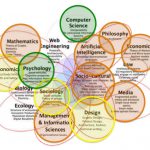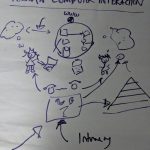I created a course about human-computer interaction (HCI) on Udemy back in 2020. It was fun and fresh and two hours long. I probably should have left it like that and then once it had earned me the equivalent of teaching a course in a university as a sessional lecturer, offered it for free.
Instead, I kept adding materials and now it’s a bit of a monster, like HCI itself, it’s a Frankenstein made up of different domains, with no core competencies, and comes in at five-and-a-half hours long. I have tried to reorganise it to satisfy those people who don’t feel that they need to know about certain aspects of HCI, giving them focused UX tools and examples whilst offering a deep dive into HCI guidelines, theory and history. However, it is still not working too well for me.
The last time I looked, it had 1,247 students, though that number fluctuates all the time. However, I won’t be looking at it anymore because it just takes up too much of my mental energy for many different reasons, including the lack of support that Udemy gives instructors and the ability to refute some of the inaccurate/uninformed comments that people have the legitimacy to leave, with 1-star reviews, which discredit the course based on their lack of knowledge about what HCI actually is.
I used to think it was a charming testament to the democracy of the Internet. I don’t anymore. Udemy’s advice is to go and argue with people in the comments. I don’t want to argue with people online. It’s just not healthy. One could argue that I should be managing student expectations better, and I have added materials to do that, but some people’s mind just cannot be changed and they’re the ones who leave one star reviews that impact the overall rating.
Just lately, it has been translated into different languages which in itself it not a bad thing, in fact at first I thought it was great, it now has Korean and Spanish audio. However, a recent review says that the Spanish audio is terrible quality, which is super disappointing, since it’s my course, and yet I had no say in how the audio sounds. After all, the course has my name on it, and I wouldn’t have provided any dodgy audio!
The other negative thing about it too is the AI assistant. Now I love AI, always have always will, and I definitely think generative AI has its place, but when it is churning out absolute twaddle about UX and HCI as it is doing, because whilst it is extraordinarily impressive, it is basically just predictive text on steroids and has no context, it doesn’t understand anything, it’s just a parrot, doing unhelpful things such as using UX and HCI as interchangeable terms which they are not. So much so that it is giving students wrong information with my name on top, then I get a bit upset. I don’t think the AI assistant is doing Udemy any favours.
I can no longer offer the course for free (Udemy has a two hour limit on free courses) unless I constantly create coupons.
Here’s my latest:
https://www.udemy.com/course/human-computer-interactions/?couponCode=EXPIRESDEC10
Ruth’s HCI course on Udemy
I no longer wish to keep updating it as it has long passed the point of diminishing returns, so I need to take a long hard look at it and decide what to do with all of the materials I have there. I can’t take it down as people have bought it, but I could retire it so no one new can buy it. Or, I could leave it as it is.
There is a lot of great stuff in there and in fact other people who teach HCI on Udemy are students on my course, so go figure! I guess they’ve probably put some of my stuff in their course, so it will keep getting to the students one way or another whether I have a course on Udemy or not.
I really don’t know. I loved this whole online course creation experience, until I didn’t, but I have learnt a lot about course creation and so I’m pondering what to do.
Read more about the course content here:
[ Part 2: Ruth’s Human-Computer Interactions on Udemy ]






